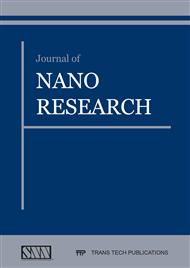p.1
p.18
p.32
p.41
p.48
p.57
p.72
p.78
p.90
Fabrication of Quantum Dots Light Emitting Device by Using CdTe Quantum Dots and Organic Polymer
Abstract:
Cadmium telluride CdTe QDs was prepared by chemical reaction and used to fabricate electroluminescence quantum dot hybrid junction device. QD-LED was fabricated using TPD: PMMA/CdTe/Alq3 device which synthesized by phase segregation method. The hybrid white light emitting devices consists, of three-layers deposited successively on the ITO glass substrate; the first layer was of Tetra-Phenyl Diaminobiphenyl (TPD) polymer mixed with polymethyl methacrylate (PMMA) polymers, while the second layer was 0.5wt% of the (CdTe) QDs for hybrid device, whereas the third layer was Tris (8-hydroxyquinoline) aluminium (Alq3). The optical properties of CdTe QDs were considered by UV-Vis. and photoluminescence (PL) spectrometer. The results show that the prepared QDs were nanocrystalline with defects formation. The Eg calculated from PL were 2.25 eV for Cadmium telluride CdTe QDs was prepared by chemical reaction and used to fabricate electroluminescence quantum dot hybrid junction device. QD-LED was fabricated using TPD: PMMA/CdTe/Alq3device which synthesized by phase segregation method. The hybrid white light emitting devices consists, of three-layers deposited successively on the ITO glass substrate; the first layer was of Tetra-Phenyl Diaminobiphenyl (TPD) polymer mixed with polymethyl methacrylate (PMMA) polymers, while the second layer was 0.5wt% of the (CdTe) QDs for hybrid device, whereas the third layer was Tris (8-hydroxyquinoline) aluminium (Alq3). The optical properties of CdTe QDs were measuredby UV-Vis. and photoluminescence (PL) spectrometer. The results show that the prepared QDs were nanocrystalline with defects formation. The Eg calculated from PL were 2.25 eV for CdTe QDs. The generated white light properties with acceptable efficiency using confinement effect that makes the energy gap larger, thus the direction of the light sites are toward the center of white light color. The organic light emitting device (OLED) wasconsidered by room temperature PL and electroluminescence (EL). Current-voltage (I–V) characteristics indicate that the output current is good compared to the few voltage (6 V) used which gives good results to get a generation of white light. The electroluminescence (EL) spectrum of hybrid deviceshows a wide emission band covering the range from 350 - 700 nm. The emissions causing this white luminescence were identified depending on the chromaticity coordinates (CIE 1931) was found (x=0.32, y=0.33). The correlated color temperature (CCT) was found to be about 5886 K. Fabrication of EL-devices from semiconductors material (CdTe QDs) between two layers organic polymer (TPD) and organic molecules (Alq3) were effective in white light generation. The recombination processes and I-V characteristics gives rises to the output current is good compared to the few voltages used which gives good results to become a generation of light.
Info:
Periodical:
Pages:
48-56
Citation:
Online since:
November 2017
Authors:
Keywords:
Price:
Сopyright:
© 2017 Trans Tech Publications Ltd. All Rights Reserved
Share:
Citation:


